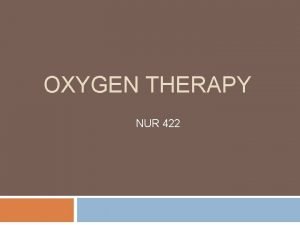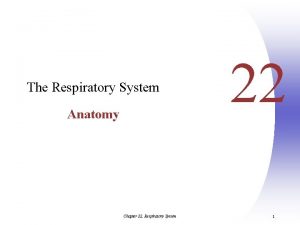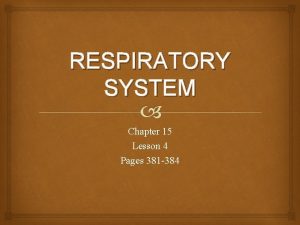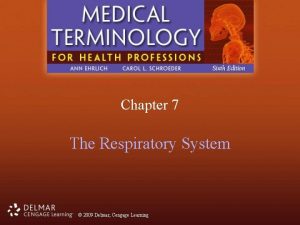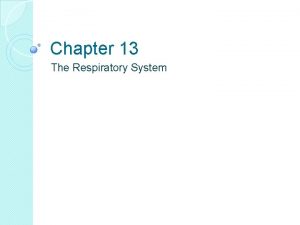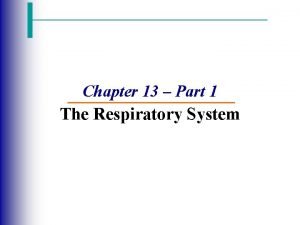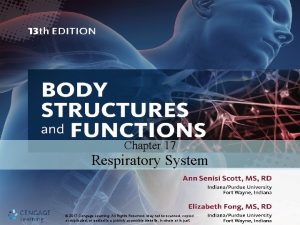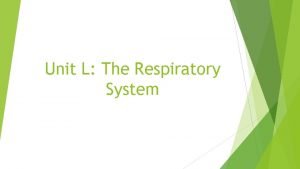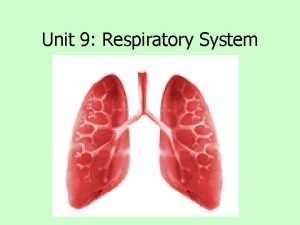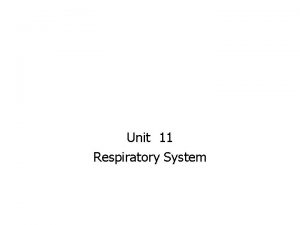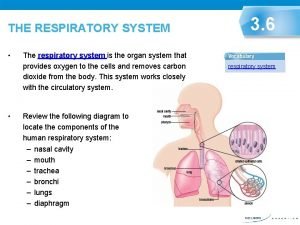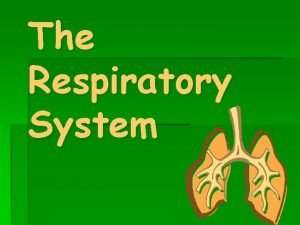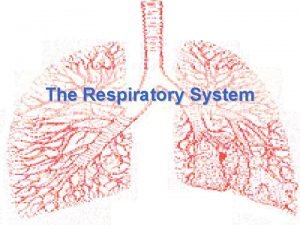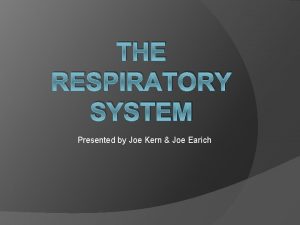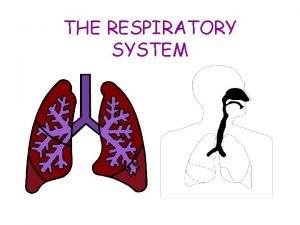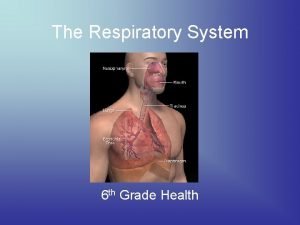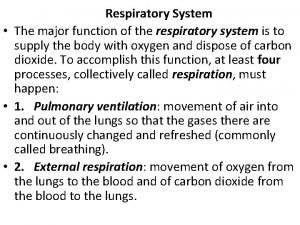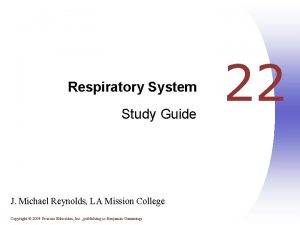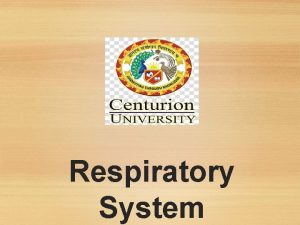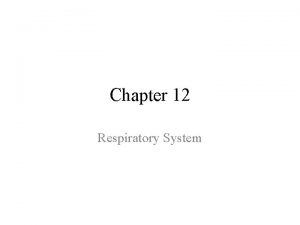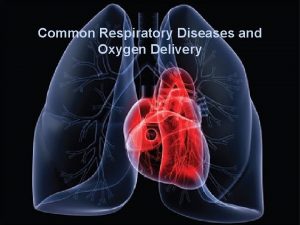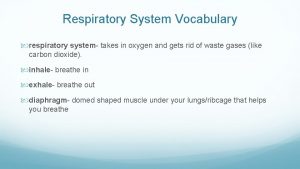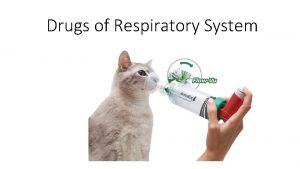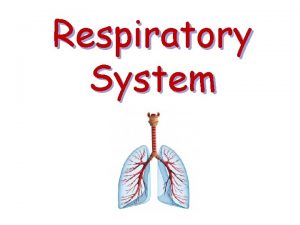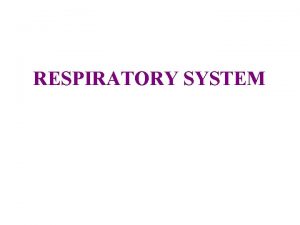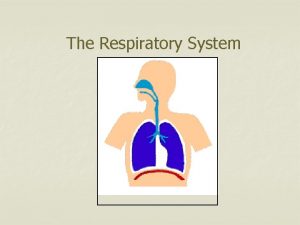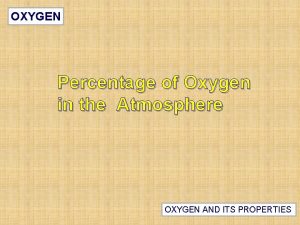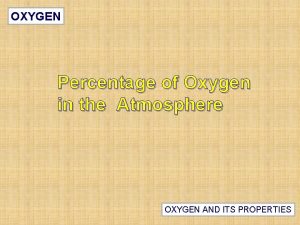Chapter 12 Respiratory System Oxygen Delivery A Cooperative

































- Slides: 33

Chapter 12 Respiratory System

Oxygen Delivery: A Cooperative Effort • Respiratory & cardiovascular system work together – Respiratory system: – Cardiovascular system:

Overview of the respiratory system

Structure & Function of the Lungs • Lungs – Divided into several segments called: • Left lung has: • Right lung has: – These segments are made up of smaller units called:

Structure & Function of the Lungs • Consists of a system of tubes that conduct air into and out of the lungs – Bronchi: – Bronchioles: – Terminal bronchioles: – Respiratory bronchioles: • Lead to alveolar ducts and sacs which contain multiple alveoli

The Lower Respiratory Tract Larynx Trachea Right bronchus Clusters of alveoli Left bronchus Bronchioles Figure 10. 3

Structure & Function of the Lungs • Alveoli: – Small air space bounded by a thin epithelial wall called: – Alveoli are surrounded by pulmonary capillaries • These conditions promote: – Some cells is the septum produce a lipid material called: • This material

Structure & Function of the Lungs Fig. 12 -2 B

Respiration • Two functions of respiration: – Ventilation: – Includes: • Inspiration: • Expiration: – Gas Exchange: • Gases diffuse between blood, tissues, and pulmonary alveoli due to: Alveolar air ↑ P 02 105 mm. Hg ↓ PC 02 35 mm. Hg Blood (Pulmonary capillaries) P 02 20 mm. Hg PC 02 60 mm. Hg

Respiratory Cycle Figure 10. 9

Pleural Cavity • Pleura: • Pleural cavity: • Intrapleural pressure: – Normally less than the pressure within the lungs (intrapulmonary pressure) • This holds the lungs: – Referred as “negative pressure” or subatmospheric because it is less than atmospheric pressure

Pneumothorax • Loss of negative intrapleural pressure which leads to: – Causes: • Lung injury or pulmonary disease that allows: • Stab wound or penetrating injury to chest wall that permits: • Sometimes occurs without any apparent cause & is called: spontaneous pneumothorax – Occurs in: tall, white, males

Pneumothorax • Tension pneumothorax (A. K. A. sucking chest wound) – Development of: – With inspiration intrapleural pressure: • Air flows: – With expiration intrapleural pressure: • Hole is plugged by tissue & air is: – Pressure builds up in pleural cavity causing:

Pneumothorax • Manifestations – Chest pain – Shortness of breath – Reduced breath sounds on affected side – Chest x-ray: lung collapse + air in pleural cavity

Pneumothorax • Treatment: – Chest tube inserted into pleural cavity; left in place until tear in lung heals • Prevents: • Usually has a one way valve only allowing air to leave during expiration • Aids re-expansion of lung

Pneumothorax

Atelectasis • Collapse of all or part of a lung • Two types: – Obstructive atelectasis – Compression atelectasis

Atelectasis – Obstructive atelectasis: • Complete blockage of a bronchus by: • Air is absorbed from the blocked section of lung leading to: • If obstruction is relieved: • Can sometimes develop as a postoperative complication – Coughing and breathing are decreased – Mucous accumulates – To prevent this patients are encourage to breath deeply & cough

Atelectasis • Compression atelectasis: – Results when: – This prevents:

Pneumonia • Inflammation of the lung – Exudate spreads through the lung and fills the: – Affected portion of lung becomes relatively solid which is referred to as: – Can be classified in three ways: • Etiology • Anatomic distribution of inflammation • Predisposing factors

Pneumonia • Etiology: – Most important because: • Anatomic distribution of inflammation • Predisposing factors

Pneumonia • Symptoms: • Treatment: – Bacterial: – Viral:

Pneumonia

Tuberculosis • Special type of pneumonia caused by the bacterium: • Acquired by: – Primary infection is walled off with a central region of necrotic cells which is called:

Tuberculosis • Infection usually stopped and granulomas heal with scarring • Symptoms usually caused: • Infection can be reactivated: • Diagnosis – Skin test (Mantoux) – Chest x-ray – Sputum culture • Treatment: – With antibiotics & chemotherapeutic agents

Tuberculosis

Tuberculosis • Rare types of tuberculosis – Miliary tuberculosis: • Develops if tuberculous infection erodes into a large blood vessel: – Extra pulmonary tuberculosis: • Infection develops in other location of the body such as:

Bronchitis & Bronchiectasis • Acute bronchitis – Inflammation of lining of: – Commonly follows: • Chronic bronchitis – Results from: – Caused by: • Severe inflammation causing weakening & dilation of the bronchial wall is called: – Leads to:

Chronic Obstructive Lung Disease • Pulmonary disease caused primarily by chronic irritation due to smoking • It is a combination of chronic bronchitis & emphysema – Emphysema • COPD is characterized by the following anatomic changes

Chronic Obstructive Lung Disease • Effects: – Individuals need to generate more pressure to breath out:

Chronic Obstructive Lung Disease • COPD – Symptomatic treatment: • • • Bronchodilators Mucolytics Cough suppressants Inhalers Avoidance of contact with people with URIs

Bronchial Asthma • Muscular spasms in the walls of: • Increased secretions by the: • Person may exibit: • Cause: – Usually: – Can be: • Treat with:

? ? QUESTIONS? ? 33
 Conductive zone vs respiratory zone
Conductive zone vs respiratory zone Respiratory digestive and circulatory system
Respiratory digestive and circulatory system T piece oxygen delivery
T piece oxygen delivery 3 liters fio2
3 liters fio2 Venturi mask oxygen flow rate
Venturi mask oxygen flow rate Tracheostomy oxygen delivery
Tracheostomy oxygen delivery Tiny air sacs at the end of the bronchioles
Tiny air sacs at the end of the bronchioles Circulatory system and respiratory system work together
Circulatory system and respiratory system work together Chapter 7:10 respitory system
Chapter 7:10 respitory system Bronchide
Bronchide Respory
Respory Chapter 15 lesson 2 the respiratory system
Chapter 15 lesson 2 the respiratory system Chapter 7 the respiratory system labeling exercises
Chapter 7 the respiratory system labeling exercises Chapter 34 circulation in humans concept mapping answer key
Chapter 34 circulation in humans concept mapping answer key Respiratory system organs
Respiratory system organs Chapter 13 respiratory system figure 13-4
Chapter 13 respiratory system figure 13-4 Chapter 17 respiratory system workbook answers
Chapter 17 respiratory system workbook answers Complete the statements accenture delivery suite
Complete the statements accenture delivery suite Treacability
Treacability Respiratory system bozeman
Respiratory system bozeman Unit 9 respiratory system
Unit 9 respiratory system Diagnostic test of respiratory system
Diagnostic test of respiratory system What is the respiratory system
What is the respiratory system Larynxobudy
Larynxobudy Respiratory system coloring page
Respiratory system coloring page Respiratory system purpose
Respiratory system purpose Respiratory system conclusion
Respiratory system conclusion Respiratory system jobs
Respiratory system jobs Interesting facts about respiratory system
Interesting facts about respiratory system Upper and lower airway
Upper and lower airway Imagine
Imagine Upper respiratory tract
Upper respiratory tract Respiratory system diagram unlabeled
Respiratory system diagram unlabeled Respiratory system vocabulary
Respiratory system vocabulary


